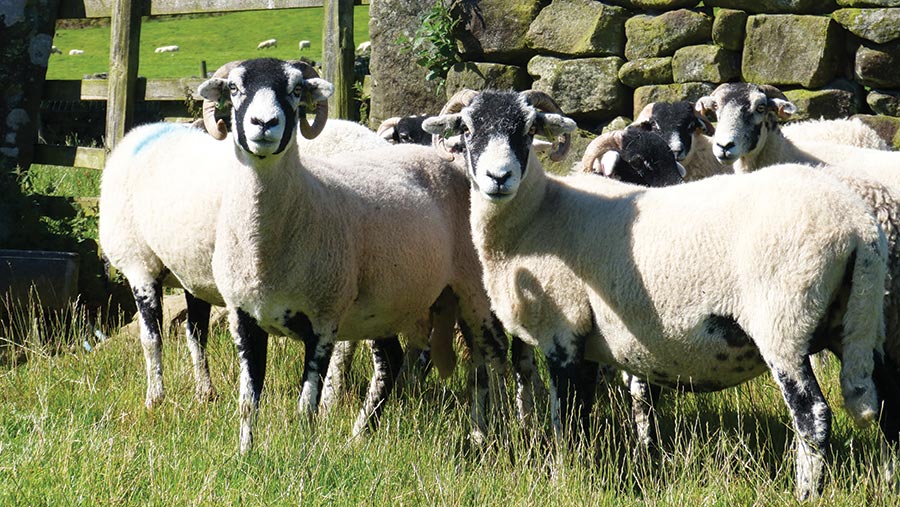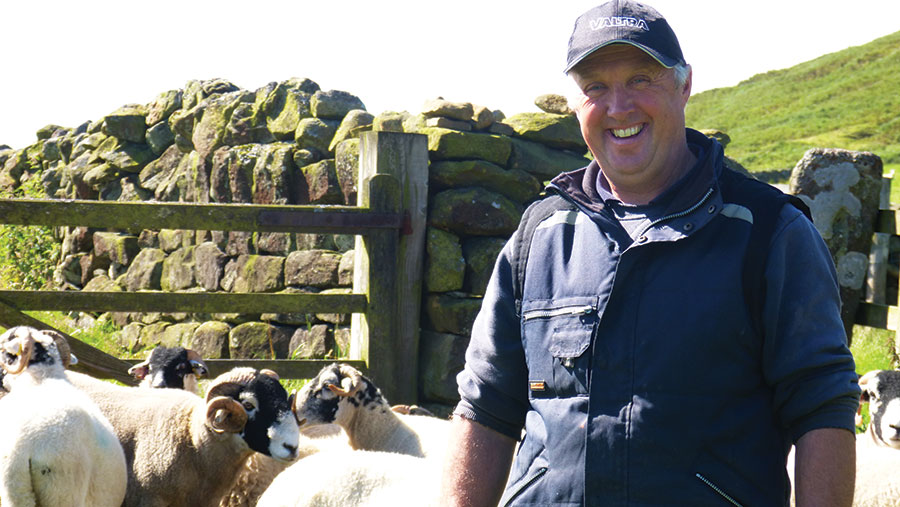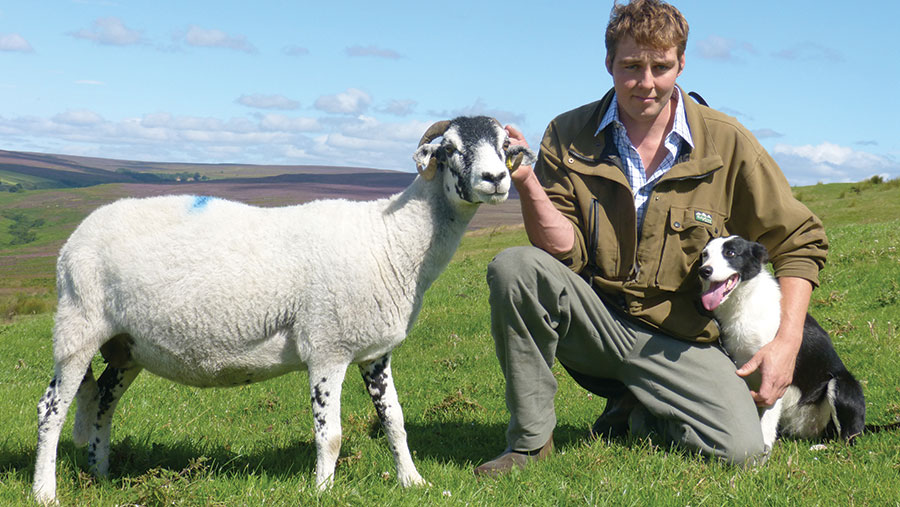How Swaledale breeders found tups with better performance

A group of pioneering farmers have overcome the inherent challenges of performance recording hill breeds to make significant genetic progress in their Swaledale flocks.
The three-year AHDB project has ended, but after recording 67 tups, the six farms all intend to forge ahead by continuing to Signet-record their flocks.
Performance recording is challenging in the Swaledale breed because:
- Traditionally, breeding sheep are selected on phenotype (looks) based on markings, heads and colour
- The Swaledale Sheep Breeders Association don’t permit the use of artificial insemination
- It is difficult to gather data in a hill environment
- Cost is high: £95 subscription + £2.50 a ewe (up to 50 ewes) + £0.50 a ewe thereafter and £1.75 to scan each lamb.
See also: Swaledale breeders embark on performance-recording project
Individual farm aspirations vary, but the main focus is to improve carcass traits by measuring loin, hind leg and shoulder.
Project facts
- Monitored lamb finishing on three breeding farms and one finishing unit
- The other farms involved were Andy Fawbert, Farndale; Lewis Barraclough, Rosedale; Richard Sellars, Cropton; and Mark Graham, Goathland
- Project consultant was independent sheep expert Kate Phillips
With most Swaldale breeders single-sire mating and recording parentage anyway, the group found recording extra birthweight and birth data fitted in alongside normal shepherding jobs.
The EU-funded project subsidised recording costs, electronic tag reading and flock management software and an electronic weigh scale.
Farmers Weekly spoke to two of the farmers in the project, Barry Wheldon and Tim Dunn, about their experiences, the benefits and what they have learned.
Case study: “I’m now breeding a performance Mule”
Swaledale and Mule breeder Tim Dunn is now recording all his Swaledales after taking part in the performance-recording study and even started recording his Bluefaced Leicester flock last year.

A total of 750 sheep on three hefts are now recorded at Breck House, Fadmoor, after previously recording just one heft of about 160 ewes.
Farm facts
- Swaledale tups sold at Ruswarp and Hawes. Recorded Swaledales lamb from 1 May and all are tupped pure for two cycles
- Hefted flocks running to 460m above sea level, with data being recorded outside
- 93ha of rented in-bye and 53ha owned
- Running 1,400 Swaledales on grazing rights, with about 450 put to Bluefaced Leicesters to produce North of England Mules
Mr Dunn is one year into recording Bluefaced Leicesters, with a view to be able to market all his Mules as “performance Mules” by 2025.
This follows three years of data collection in which the Dunns discovered the marked difference in performance between their high and low index tups (see “The carcass difference between high- and low-index rams”, below).
Mr Dunn says it’s possible to combine a high-index, maternal ability and good breed type in one animal.
The carcass difference between high- and low-index rams |
||
|
|
Ram 1 |
Ram 2 |
|
Index |
Low index (bottom 1%) |
High index (top 5%) |
|
Scan weight |
33.9kg |
36.4kg |
|
Loin depth |
17.81mm |
19.51mm |
|
Loin fat |
1.65mm |
2.3mm |
Breeding goals
Mr Dunn’s aim is to improve carcass grades, weights and profitability, while ensuring fat cover, litter size, lambing ease, breed type and milk are maintained or improved.
So far, the strategy has been to collect all the data possible during the project and simply start weeding out the lower-index rams.
Now, the plan is to breed high-index tups (180+) to high-index females and match a group of 50 elite females to high-index rams to lift the elite group.
“Some Swaledale breeders are concerned we are purely focusing on index and conformation. This is not the case,” stresses Mr Dunn.
“We are striving to find tups that combine type and figures. The group is looking for new breeders to join to increase the data set and rate of genetic gain.”
Marketing difficulties
The group’s next step is to start marketing sheep as performance recorded and high index.
However, the number of high-index tups forms a very small percentage of the total number of Swaledale tups on offer.
Case study: Recording saves up to 45 days on lamb finishing
Swaledale breeder Barry Wheldon says using higher-index rams is reducing lamb finishing times by 45 days on average.

All the Swaledale sheep that are bred pure have been recorded from the outset at Birk Nab Farm, Carlton, where Mr Wheldon hopes to improve days to slaughter and conformation of the lambs he sells annually to Dunbia.
Farm facts
- 1,120 ewes and 50 suckler cows on 231ha of in-bye land and grazing rights for 470 ewes in hefted flock up to 360m above sea level
- Stratified sheep farm breeding own replacements and breeding surplus females
- Lambs finished and sold to Dunbia
- 470 Swaledales bred pure, 300 Swaledales drafted and bred to Aberfield or Bluefaced Leicester and 350 Mules bred to terminal sires
- Swaledale lambing starts on 1 May for two cycles (one pure, one to Charollais)
- Average growth rates of 221g/day (zero to eight-week weight) and 160g/day (eight to 21 weeks)
- 40-50-head tupping groups
The difference between a tup within the top 2% (214 index) and a bottom 50% tup (67 index) is 30g a head a day in terms of daily liveweight gain, says Mr Wheldon, who has been weighing progeny at birth, weaning and back-fat scanning.
At an average daily liveweight gain of 170g and 140g respectively and a birthweight of about 4.3kg, this meant the high-index tup’s progeny needed 210 days to hit 40kg liveweight, compared to the lower-index tup’s progeny, which required 254 days.
Flock aims
The aim is to breed a lightweight Swaledale ewe that produces a 16kg prime lamb carcass, which can grow and be finished on grass with little cost.
“We want to keep a hardy, milky ewe with good mothering ability and Swaledale type, but we want to do that while finding the genetics that grow well and thrive in our environment.”
Five lessons learned from recording
- Consider weaning earlier: Studying growth rates highlighted a weight-gain drop in late summer on heather moorland. Mr Dunn and Mr Wheldon now wean four-to-five weeks earlier than they did and put weaned lambs on better grass.
- Finish heavy lambs if possible: Winter weight-gain data through the winter showed large Swaledale lambs are best finished in the autumn because they go through a mid-winter hibernation period before starting to grow faster once daylight starts lengthening in January.
- Change weigh bag daily: Breeders who took birthweights found that if they used a bag, the bag could develop a lamb smell, which could lead to mis-mothering. Signet allowed the breeders to estimate weights after weighing a few lambs initially to make the recording workable in a hill environment. Small = 2.5kg, medium = 3-3.5kg, big 4kg or very big = 5kg.
- Leave lambs to bond: If lambs aren’t licked dry and bonded at the time of the daily lambing check then leave them. Return the following day to weigh and record the lamb.
- Choose lambing fields carefully: Stones, vegetation and steep banks can make recording difficult. Fields that allow bikes to travel easily help record data quickly at lambing.e
